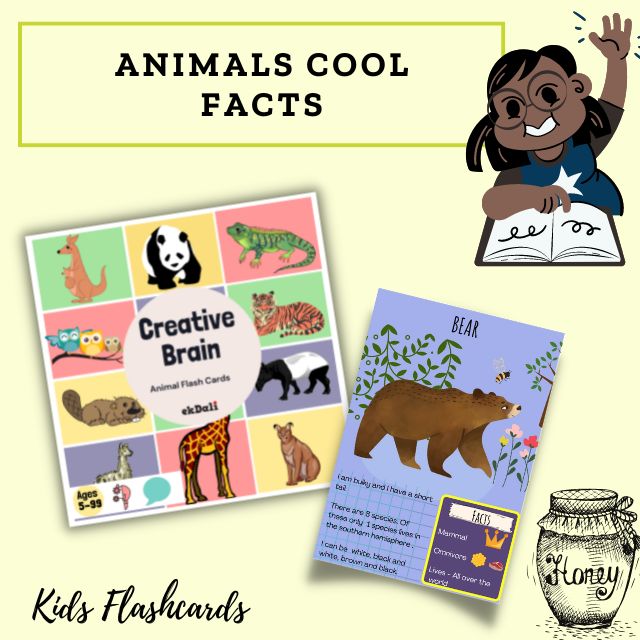The above flashcard on bears is part of the Creative Brain - Animals of the World Flashcard set. You may buy the flashcards for a great screen free learning experience for kids
- Bears are carnivoran mammals of the family Ursidae. They are classified as caniforms or doglike carnivores. Appearing in a wide variety of habitats throughout the Northern Hemisphere and partially in the Southern Hemisphere.
- There are eight different species of bears: North American black bears, brown bears, polar bears, Asiatic black bears, Grizzly bears, panda bears, sloth bears, and sun bears.
- Whatever species it may be, all bears evolved with distinctly large bodies and stocky limbs. Bears tend to have small, rounded ears, as well as shaggy coats of fur. They all walk flat-footed, unlike other animals like humans with arced feet. Each bear also has 5 fixed claws on each paw, as well as short, bushy tails.
- A polar bear’s coat is made up of two unique layers. The shorter coat provides insulation from weather, while the longer coat prevents water from reaching the short coat layer and skin. Each layer serves a unique purpose and allows bears to thrive in frigid conditions.
- Polar bears, the largest of all bear species, can weigh between 900-1500 pounds and grow approximately 6-10 feet long.
- Black bears are the smallest bear species in North America. The males can grow up to 600 pounds, while the females only reach around 200 pounds.
- Grizzly bears possess a massive biting force, which is enough to crush a bowling ball or an iron skillet. Adult grizzly bears can run up to an incredible 40mph, the same pace as a greyhound, and would break the speed limit on many roads.
- Grizzly bears can remember hotspots for food even after ten years, and some have even been observed covering their tracks or hiding behind rocks and trees to avoid detection by hunters. Grizzly bears have also learned to camouflage their scent by rolling around in rotting flesh to sneak up on prey.
- In the days leading to winter, bears consume a lot of food (around 20,000 calories daily). This helps them to gain enough weight, to sustain themselves throughout winter. Bears will hibernate in holes they dig in various locations, especially under big rocks or logs. During hibernation, bears don’t drink, eat or even defecate. They recycle their urine in the form of protein. The heartbeat of a bear goes as low as 8 beats a minute during hibernation.
- Unlike mammals of similar sizes like the cows, bears only have one stomach. Bear intestines are also very short and undifferentiated, which limits the amount of nutrition they can get from their food.
- Perhaps one of the lesser-known facts about bears is that they are among the most intelligent land animals in North America. They have the largest and most complex brains compared to other land mammals their size, and they rely on this brain for several behaviors.
- Bears make their dens using their claws to burrow out enough space for themselves, before using logs to hide their dens. However, bears may also use naturally-occurring caves or crevices as dens instead of building their own.
- Clicking and grunting are usually signs of a friendly bear. These sounds are usually shared between a mother bear and her cubs. Barking is a sign of alarm or excitement. Popping sounds usually indicate a show of warning, while bellows, growls, and roars are always signs of aggression.
- A bear’s sense of smell is usually greater than dogs and other predators. In addition to locating prey and other sources of food, bears use their sense of smell to find other bears. They also use it to signal each other, usually either to warn rivals that they’re entering their territory.
- On average, bears live for up to 25 years. Although this is short compared to a human’s 80 years, the bear’s life span is quite long compared to other mammals.
|
FOOD |
FISH, GRAIN, BERRIES, INSECTS, BIRDS, MAMMALS |
|
GENDER NAMES |
MASCULINE-BOAR, FEMININE-SOW |
|
YOUNG ONES |
CUBS |
|
COLOUR |
BROWN, BLUE, GREY, BLACK, WHITE, BLONDE |
|
SIZE |
LENGTH:50-75 INCHES, WEIGHT: 60KG TO 300KG |
|
LIVES IN |
NORTH AMERICA, SOUTH AMERICA, EUROPE, ASIA |
HERE IS A FUN QUIZ ABOUT BEARS, THAT YOU CAN ATTEMPT. THIS IS BASED ON WHAT YOU HAVE READ SO FAR
- How do bears communicate?
- What is the life expectancy of a bear?
- Name two species of bear?
- How do bears make their den.
- Which is the largest bear species?
- Where do bears hibernate?
- Can grizzly bears run?
- How many claws does the bear have on each paw?
ANSWER TO THE QUIZ
- Bears communicate by grunting, growling, roaring, and barking.
- Bears have a life expectancy of 25 years.
- Grizzly bears and Black bears.
- Bears make their dens using their claws to burrow out enough space for themselves.
- Polar bears are the largest bear species.
- Bears will hibernate in holes they dig in various locations, especially under big rocks or logs.
- Adult grizzly bears can run up to an incredible 40mph.
- They have 5 claws in each paw.
Products related to this post
World Map with Animals and Landmarks
























